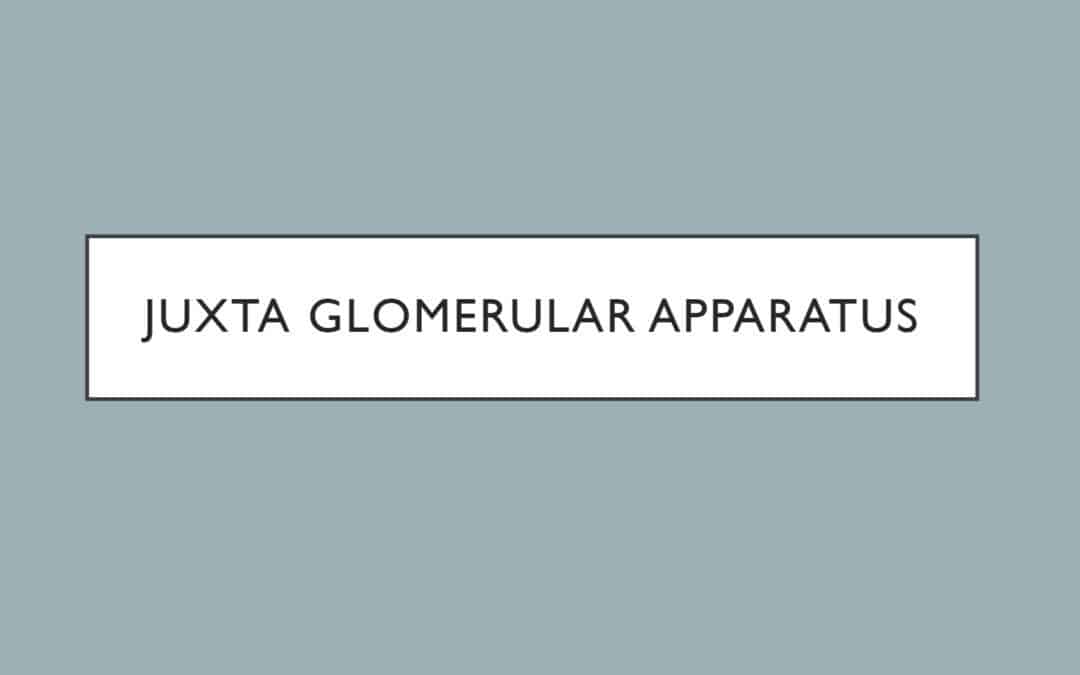DEFINITION :-
Juxta means near. Hence , it is a specialized organ which is situated just near the glomerulus of each nephron.
STRUCTURES OF JUXTAGLOMERULAR APPARATUS :-
Juxtaglomerular apparatus includes three important structures:- 1. Macula densa 2. Extraglomerular mesangial cells 3. Juxtaglomerular cells
MACULA DENSA
1. macula densa is the terminating portion of the thick ascending segment that runs in between the afferent and the efferent arteriole of the same nephrons.
2. In this thick ascending segment , the epithelial cells are tightly packed.
EXTRAGLOMERULAR CELLS
1. These cells are located in the triangular regions bound by the afferent arterioles , efferent arterioles and macula densa.
2. These cells are also known as agranular cells and lacis cells.
3. Extraglomerular mesangial cells secretes prostaglandin and cytokines.
GLOMERULAR MESENGIAL CELLS
1. Glomerular mesengial cells are also known as intraglomerular mesengial cells.
2. It is located in between the glomerular capillaries and forms the cellular networks which supports the capillaries loops.
3. These cells are contractile in nature and plays an important role in the glomerular filtration.
4. These cells are also phagocytic nature.
5. It secretes matrix of glomerular interstitium , prostaglandins and cytokines.
FUNCTIONS OF JUXTAGLOMERULAR APPARATUS
SECRETION OF RENIN a. Juxtaglomerular cells secrete renin. b. Renin is a type of peptide which contains 340 amino acids. c. Renin combines with angiotensins to form renin- angiotensin system which plays an important role in the maintainance of the blood pressure.
RENIN-ANGIOTENSIN SYSTEM:-
Renin gets released into blood , it acts on the specific plasma protein which is known as angiotensinogen or renin substrate.
It is the α2 globulin.
Angiotensinogen gets converted into decapeptidecalled angiotensin i by the activity of renin.
Angiotensin i gets converted into angiotensin ii which is an octapeptide by the activity of angiotensin converting enzyme {ace} secreted from lungs.
Most of the conversions of angiotensin i to angiotensin ii occurs in the lungs.
Angiotensin ii gets degraded into heptapeptide called angiotensin iii by angiotensinases and these are present in rbcs and vascular beds in many tissues.
Angiotensin iii gets converted into angiotensin iv which is a hexapeptide
STIMULANTS FOR RENIN SECRETION:-
IT IS STIMULATED BY 4 FACTORS:- 1. Fall in arterial blood pressure. 2. Reduction in the ecf volume. 3. Increased sympathetic activity. 4. Decrease load of sodium and chloride in macula densa.
ACTIONS OF ANGIOTENSINS:-
i. ANGIOTENSIN I
It is physiologically inactive and serves only precursors for the angiotensin ii.
ii. ANGIOTENSIN II
Angiotensin is the most active form. it acts on blood vessels , adrenal cortex , kidney , brain , growth factor in heart.
It regulates the glomerular filtration rate.
Increases the blood pressure.
Increases the water intake.
Increases the adh secretion.
Increases the crh and acth secretion.
iii. ANGIOTENSIN III
1. IT INCREASES THE BLOOD PRESSURE .
2. IT STIMULATES ALDOSTERONE SECRETION FROM ADRENAL CORTEX that is it increases the aldosterone secretion.
3. IT HAS 100% ADRENAL CORTICAL STIMULATING ACTIVITY AND 40% VASOPRESSOR ACTIVITY OF ANGIOTENSIN II.
4. causes vasoconstriction.
iv. ANGIOTENSIN IV
1. It has adrenal cortical stimulating and vassopressor activities.
Secretion of other substances :-
- Extraglomerular mesangial cells of juxtaglomerular apparatus secrets prostaglandin.
- Recently it was observed that , there is in vitro secretion of cytokines like il-2 and tnf.
- Macula densa also secretes thromboxane a2.
REGULATION OF GLOMERULAR BLOOD FLOW AND GLOMERULAR FILTRATION RATE
Macula densa of juxtaglomerular apparatus plays an important role in the feedback mechanism called tubuloglomerular feedback mechanism which regulates the renal blood flow and glomerular filtration rate.
Contributor- Medico Abinash Jena





Thanks for Sharing
Good information